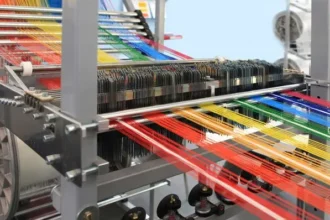Pneumatic systems are the unsung heroes of countless industries, driving efficiency and performance behind the scenes. Yet, just like any other mechanical system, they can suffer from wear and tear that affects their effectiveness. Enter Tribupneu—a groundbreaking advancement in tribology tailored specifically for pneumatic applications. This innovative technology harnesses the power of advanced tribological principles to enhance performance, reduce friction, and extend equipment lifespan.
As industries strive for higher productivity and lower operational costs, understanding this new frontier becomes essential. What if you could optimize your pneumatic systems with a solution designed to tackle common challenges head-on? From manufacturing floors to aerospace engineering, Tribupneu is reshaping how businesses approach their pneumatic operations.
Join us as we dive deeper into the world of Tribupneu—exploring its development, key features, real-world applications across various sectors, and future potential that could change everything you know about pneumatic system performance. Get ready to discover how this revolutionary technology is setting new standards in reliability and efficiency!
Understanding Tribology and Its Importance in Pneumatic Systems
Tribology is the study of friction, wear, and lubrication. It plays a crucial role in various mechanical systems, including pneumatic ones. Understanding tribological principles helps engineers design more efficient systems that minimize energy loss.
In pneumatic systems, air pressure drives components to perform tasks. However, friction can hinder their operation. Excessive wear leads to downtime and increased maintenance costs.
By applying tribological insights, manufacturers can enhance component longevity and performance. This results in smoother operations with reduced risk of failure.
Lubrication strategies are key in minimizing contact between surfaces within these systems. Effective lubrication reduces heat generation and prolongs equipment life while maintaining efficiency.
As industries continue to evolve towards automation and precision engineering, the importance of tribology becomes even more pronounced in optimizing pneumatic systems for durability and reliability.
The Development of Tribupneu Technology
The evolution of Tribupneu technology marks a significant leap in pneumatic system engineering. With roots in advanced tribology, this innovation integrates cutting-edge materials and design principles to enhance performance.
Initially, researchers focused on understanding friction and wear in pneumatic systems. They discovered that optimizing these factors could lead to improved efficiency and longevity.
This led to the creation of specialized coatings and lubricants designed for rigorous environments. These enhancements help reduce energy consumption while increasing reliability.
As industries sought better solutions for air-powered applications, collaboration between engineers and material scientists flourished. The result is Tribupneu—a product born from extensive testing and real-world feedback.
Now, manufacturers can achieve unprecedented levels of performance with minimal maintenance needs through this groundbreaking technology. It promises not only enhanced productivity but also sustainability benefits across various sectors.
Key Features and Benefits of Tribupneu
Tribupneu stands out in the pneumatic system landscape due to its innovative design and functionality. One of its key features is the advanced tribological materials used, which enhance friction reduction. This results in smoother operation and longer equipment lifespan.
Another significant advantage is energy efficiency. By minimizing wear and tear, Tribupneu systems consume less power, leading to cost savings over time.
The compatibility of Tribupneu with existing pneumatic setups also deserves mention. Transitioning to this technology doesn’t require a complete overhaul; it fits seamlessly into various applications.
Enhanced performance under challenging conditions further solidifies its appeal. Whether dealing with extreme temperatures or high pressures, Tribupneu maintains reliability without sacrificing effectiveness.
Real-time monitoring capabilities provide users with valuable insights into system health. This proactive approach allows for timely maintenance interventions, reducing downtime significantly.
Real-World Applications of Tribupneu in Various Industries
Tribupneu is making waves across multiple industries by enhancing the efficiency of pneumatic systems. In manufacturing, it optimizes machinery performance, reducing downtime and maintenance costs.
The automotive sector benefits significantly from Tribupneu technology. It improves air compression in vehicles, leading to better fuel efficiency and lower emissions.
In the aerospace industry, Tribupneu plays a vital role in ensuring reliable operation under extreme conditions. Improved tribological properties lead to safer flights and longer-lasting components.
Pneumatic tools used in construction have also seen improvements thanks to Tribupneu. Enhanced lubrication reduces wear and tear on equipment, increasing productivity on job sites.
Even food processing companies are adopting this innovative technology for its ability to maintain hygiene standards while improving operational reliability. This versatility showcases how Tribupneu can address diverse challenges across various sectors effectively.
Future Potential and Advancements in Tribupneu Technology
The future of Tribupneu technology is brimming with possibilities. As industries continue to demand higher efficiency and reduced costs, Tribupneu stands at the forefront of innovation.
Advancements in materials science will likely enhance its performance even further. New composites could minimize wear and tear while maximizing energy transfer. This means longer-lasting components and less downtime for maintenance.
Artificial intelligence integration may also be on the horizon. Smart sensors could monitor real-time conditions, adjusting system parameters automatically to optimize performance.
Moreover, sustainability is becoming crucial across sectors. Tribupneu’s potential for energy savings aligns perfectly with global efforts toward greener practices.
Collaborations between engineers and researchers will drive ongoing improvements. The synergy between different fields can lead to groundbreaking applications that we can’t yet imagine. Each advancement promises to refine pneumatic systems significantly, heralding a new era in operational excellence.
How to Implement Tribupneu in Your Pneumatic System
Implementing Tribupneu in your pneumatic system requires careful planning and execution. Begin by assessing your current setup to identify areas where tribology can enhance performance.
Next, consult with experts familiar with Tribupneu technology. They will provide insights on the best configurations for your specific application.
Once you have a clear plan, gather the necessary components that align with Tribupneu specifications. Installation should be handled by trained professionals who understand both pneumatic systems and tribological principles.
After installation, conduct thorough testing to ensure everything operates seamlessly. Monitor performance metrics closely over time to gauge improvements.
Educating your team about maintenance practices is crucial as well. Proper upkeep will maximize the benefits of integrating Tribupneu into your operations, leading to enhanced efficiency and durability in your pneumatic systems.
Conclusion: The Impact of Tribupneu on the Future of Pneumatic Systems
The emergence of Tribupneu marks a turning point in pneumatic system technology. Its innovative approach to tribology not only enhances efficiency but also extends the lifespan of components.
As industries continually seek cost-effective solutions, Trib upneu stands out by reducing wear and tear. This translates into less downtime and lower maintenance costs for businesses.
Moreover, with sustainability becoming increasingly important, Trib upneu’s ability to minimize energy consumption aligns perfectly with eco-friendly initiatives. Companies can now operate more responsibly while maintaining high performance levels.
The future looks promising as further advancements in Trib upneu technology unfold. Enhanced formulations and smarter applications will likely push boundaries even further.
Adopting this cutting-edge solution could redefine operational standards across various sectors. Organizations that embrace these innovations are poised to lead the way in efficiency and productivity moving forward.
FAQs
The impact of Trib upneu on pneumatic systems is becoming increasingly evident. As industries seek to improve efficiency, reduce wear and extend equipment life, this innovative technology stands at the forefront of that transformation. The advanced application of tribology within pneumatic systems not only optimizes performance but also opens new avenues for future development.
As with any emerging technology, questions often arise regarding its implementation and effectiveness. Here are some frequently asked questions about Tribupneu:
1. **What exactly is Trib upneu?**
Tribupneu refers to a cutting-edge approach in tribology specifically designed to enhance the performance of pneumatic systems by reducing friction and wear.
2. **How does it work?**
It optimizes lubrication properties through advanced materials and coatings that significantly decrease resistance between moving parts.
3. **What industries can benefit from using Tribupneu?**
Industries such as manufacturing, automotive, aerospace, and robotics have all seen notable improvements through the integration of Tribupneu technology.
4. **Is installation complicated?**
Implementing Tribupneu typically involves retrofitting existing systems or integrating it into new installations—usually manageable with professional assistance.
5. **Can I expect immediate results after implementing it?**
While many users report quick improvements in system efficiency and reduced maintenance needs, optimal benefits may take time as adjustments are made within the system’s operation.
6. **Are there any risks associated with switching to this technology?**
Like any innovation, it’s essential to evaluate compatibility with your current equipment; however, most feedback indicates positive outcomes without significant downsides when implemented correctly.
By harnessing the power of tribology through technologies like Tribupneu, businesses can position themselves at the cutting edge of industrial advancements while maximizing their operational efficiencies for a sustainable future ahead.

















